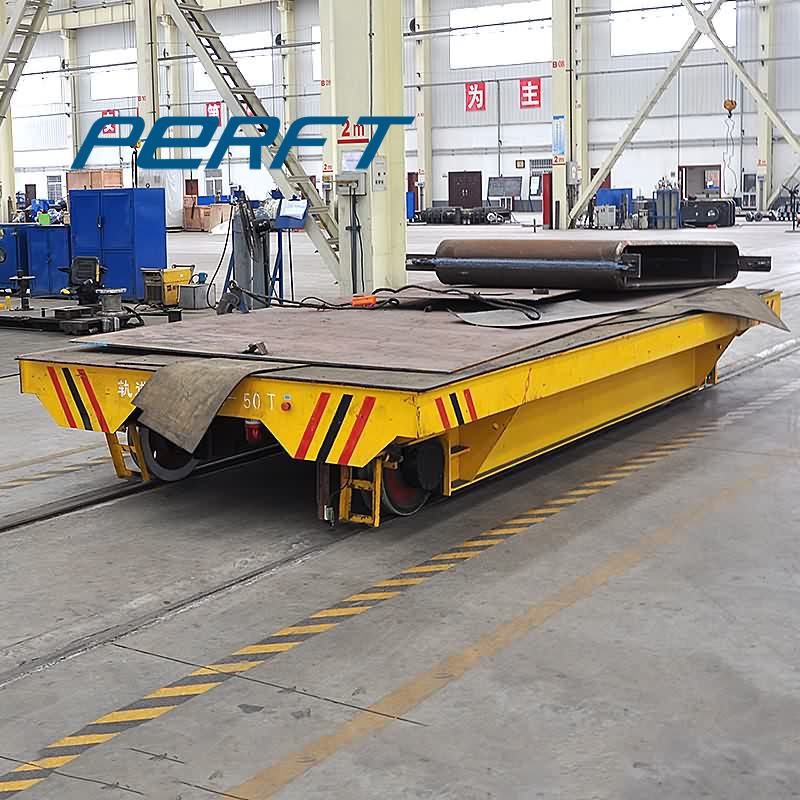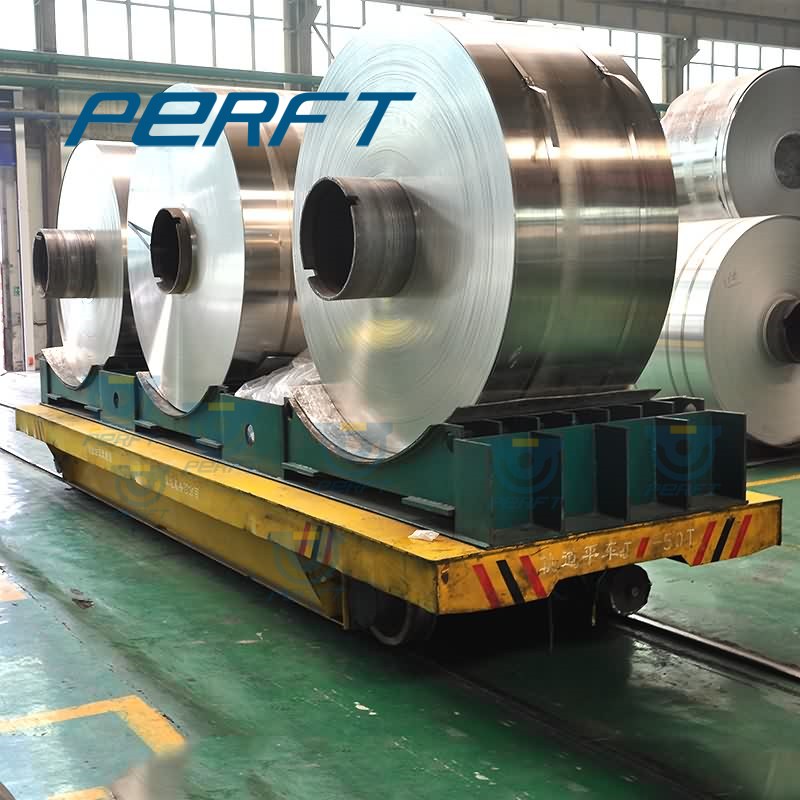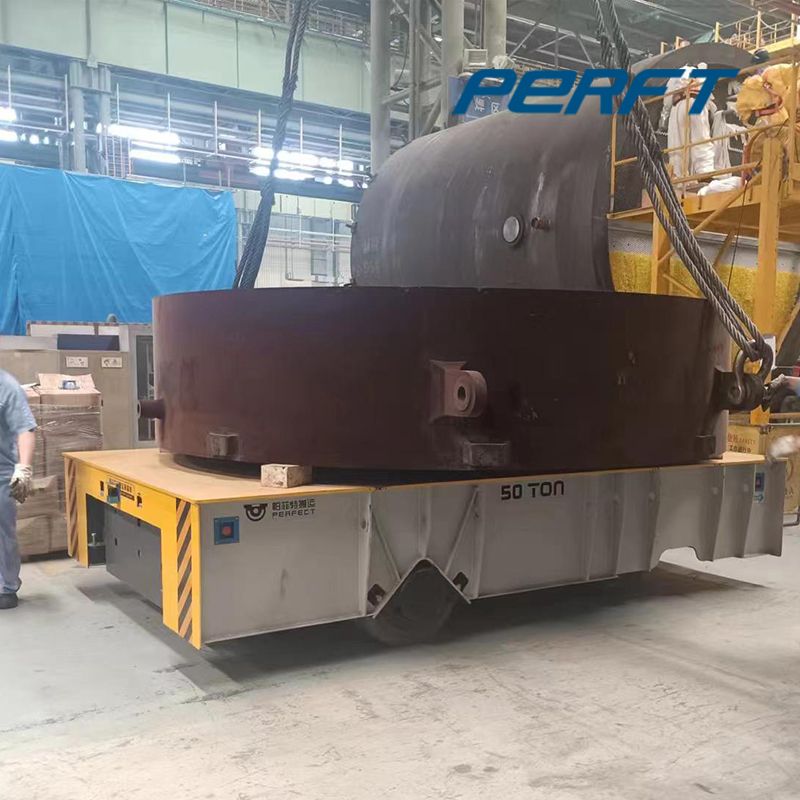Omnidirectional wheel trackless transfer cart 100 ton
Omnidirectional wheel trackless transfer cart with a capacity of 1 ton up to 500 tons, which are moved in industrial settings is revolutionized by this amazing piece of equipment. This page will discuss what an omnidirectional wheel trackless transfer cart is specifically, as well as its advantages, uses, possibilities for customization, and how to work with Perfect Manufacturer. To give you a thorough grasp of this transfer cart, we’ll also answer a few frequently asked questions.
What is an Omnidirectional Wheel Trackless Transfer Cart
An omnidirectional wheel trackless transfer cart is a specialized material handling vehicle designed to move heavy loads within industrial facilities. It has a set of wheels that are omnidirectional, so it may move in any direction without the need for rails or predetermined routes. These wheels can independently rotate 360 degrees, giving the cart unmatched flexibility and maneuverability in crowded work locations, narrow places, and abrupt curves.
Benefits of Omnidirectional Wheel Trackless Transfer Cart
- Enhanced maneuverability: This trackless transfer cart’s key benefit is its smooth mobility in any direction. This makes it perfect for institutions with limited space because it can readily navigate intricate layouts.
- Improved efficiency: Omnidirectional carts can quickly and accurately move big loads, cutting down on downtime and raising overall productivity in material handling activities.
- Reduced wear and tear: These carts have a longer lifespan and require less maintenance because they don’t need tracks, which also means less wear and tear.
- Safety: Omnidirectional wheels’ excellent control reduces the possibility of accidents and collisions, which improves safety.
- Versatility: Omnidirectional transfer carts are suitable for a wide range of industries, from manufacturing and logistics to warehousing and aerospace.
Omnidirectional Wheel Trackless Transfer Cart VS Traditional Transport Vehicles
| Feature | Omnidirectional Wheel Trackless Transfer Cart | Traditional Transport Vehicles |
| Maneuverability | Can move in any direction, 360-degree rotation | Generally move forward and backward |
| Steering | Independent wheel rotation for precise control | Typically require turning radius |
| Track Requirement | Trackless, no need for predefined paths | Often require dedicated tracks or paths |
| Turning Radius | Virtually zero turning radius | Larger turning radius |
| Space Efficiency | Ideal for tight spaces and congested areas | May struggle in confined spaces |
| Load Capacity | Typically up to 500 tons or more | Varies by vehicle type and model |
| Versatility | Suitable for a wide range of industries and applications | Limited by design and configuration |
| Maintenance | Lower wear and tear, reduced maintenance costs | Track maintenance may be necessary |
| Initial Investment | Generally higher initial investment | Potentially lower initial cost |
| Efficiency | Increased efficiency, reduced downtime | May have limitations in certain layouts |
| Customization Options | Highly customizable for specific needs | Limited customization options |
| Integration with Automation | Easily integrated with automation systems | May require additional adaptations |
| Safety | Enhanced safety features, reduced collision risk | Safety measures may vary by model |
| Environmental Impact | Battery-powered options for reduced emissions | Emissions may vary by fuel type |
Applications of Omnidirectional Wheel Trackless Transfer Cart
Omnidirectional Wheel Trackless Transfer Carts find applications in various industries, including:
- Manufacturing: They are used to transport raw materials, finished products, and heavy machinery within production facilities.
- Aerospace: These carts can move aircraft components and engines with precision, reducing the risk of damage.
- Warehousing: Omnidirectional transfer carts optimize storage and retrieval procedures by streamlining the transportation of goods inside warehouses.
- Automotive: They are used to move vehicle chassis and components on auto assembly lines.
- Ports and Logistics: In port facilities and logistics centers, these carts make it easier to handle huge cargoes and cargo containers.
How to Customize an Omnidirectional Wheel Trackless Transfer Cart
Customizing an omnidirectional transfer cart allows you to tailor it to your specific needs. Here are some customization options to consider:
- Load capacity: Specify the maximum weight the cart should carry.
- Dimensions: Determine the cart’s length, width, and height to suit your workspace.
- Power source: Choose between electric, battery-powered, or other power sources.
- Control system: Button control and Remote control or PLC
- Safety features: Incorporate safety sensors, alarms, and emergency stop mechanisms.
Producing Process of Omnidirectional Wheel Trackless Transfer Carts
Omnidirectional wheel trackless transfer carts are made through a process that includes design, fabrication, assembly, and testing. Here is a description of the procedure:
Design
Start with having a solid understanding of the needs and uses of the customer. Make thorough design blueprints that include the cart’s measurements, load capacity, wheel configuration, and control mechanism.
Material Choice
To ensure longevity and safety, select top-notch materials for the cart’s structure, wheels, and other parts.
Frame
Create the cart’s frame in accordance with the design guidelines. This frame serves as the cart’s framework and sustains the weight of the load.
Omnidirectional wheel assembly
Put the omnidirectional wheels together. The distinctive maneuverability of the cart depends on these wheels. Make certain that every wheel can turn independently, permitting 360-degree movement.
Control system installation
Install the control system, which can be automated or manual based on the design and the needs of the customer. A computer-based control interface, joysticks, or buttons could be part of the control system.
Power source integration
Integrate the selected power source based on the design. This could be hydraulic, electric, or battery-powered. Make sure the power source can support the operational needs and load capacity of the cart.
Safety features
To ensure safe operation, incorporate safety measures including proximity sensors, emergency stop buttons, and alarms.
Customization
Customize the cart based on the customer’s specific requirements, such as load, lifting, roller, and any additional features.
Testing and quality control
Function and safety features of the cart should be rigorously tested. Testing for accurate manoeuvrability, load-bearing capability, and safety precautions are included in this. Perform quality control checks to find and correct any production flaws.
Manual
Create user guides with detailed instructions for maintaining and running the cart.
Packaging and shipping
Pack the Omnidirectional Wheel Trackless Transfer Cart securely to guard against damage while in transit. Make shipping arrangements to the customer’s location, making sure everything gets there safely.
Installation and training
Send a group of technicians to the customer’s location as needed for installation and operator training. instruct personnel on how to use the cart safely and efficiently.
After-Sales Support
To ensure the cart’s continuous functionality and durability, provide after-sale assistance, including maintenance and spare parts services.
In order to create omnidirectional wheel trackless transfer carts that satisfy customer expectations and function dependably in industrial environments, precision engineering, close attention to detail, and a dedication to quality is essential. To keep these carts’ design and functionality up to date and to make use of new materials and technology, it’s crucial to be informed.
Future Trends
There are future trends in the area of material handling that relate to omnidirectional wheel trackless transfer carts:
- IoT integration: For improved automation, data analytics, and remote monitoring, expect to see increasing integration with the Internet of Things (IoT).
- Advanced navigation: These carts will become even more precise and safe as navigation technology continues to evolve.
- Sustainability: We will continue to create greener and more energy-efficient versions as environmental concerns increase.
FAQ
Q1. Are Omnidirectional Wheel Trackless Transfer Carts suitable for outdoor use?
A1. Yes, these carts can be designed for outdoor use with appropriate features like weatherproofing and all-terrain wheels.
Q2. Can they be automated for autonomous operation?
A2. Yes, Perfect Manufacturer offers automation options, allowing for autonomous operation and integration with existing systems.
Q3. What is the typical lifespan of an omnidirectional transfer cart?
A3. The lifespan can vary depending on usage and maintenance, but they are designed to be durable and have a long service life.
Back to List
-
 下午5:00Precision Docking for Rail Transfer Carts Smart Handling
下午5:00Precision Docking for Rail Transfer Carts Smart Handling -
 上午9:33C-Hooks and Coil Transfer Carts
上午9:33C-Hooks and Coil Transfer Carts -
 下午6:23Transfer Carts vs. Forklifts: Which is the Better Handling Equipment for You?
下午6:23Transfer Carts vs. Forklifts: Which is the Better Handling Equipment for You? -
 上午10:37Rail Transfer Cart Track Installation Requirements & Features
上午10:37Rail Transfer Cart Track Installation Requirements & Features -
上午9:41Electric Rail Transfer Carts: Types, Load Capacity & Selection Guide

